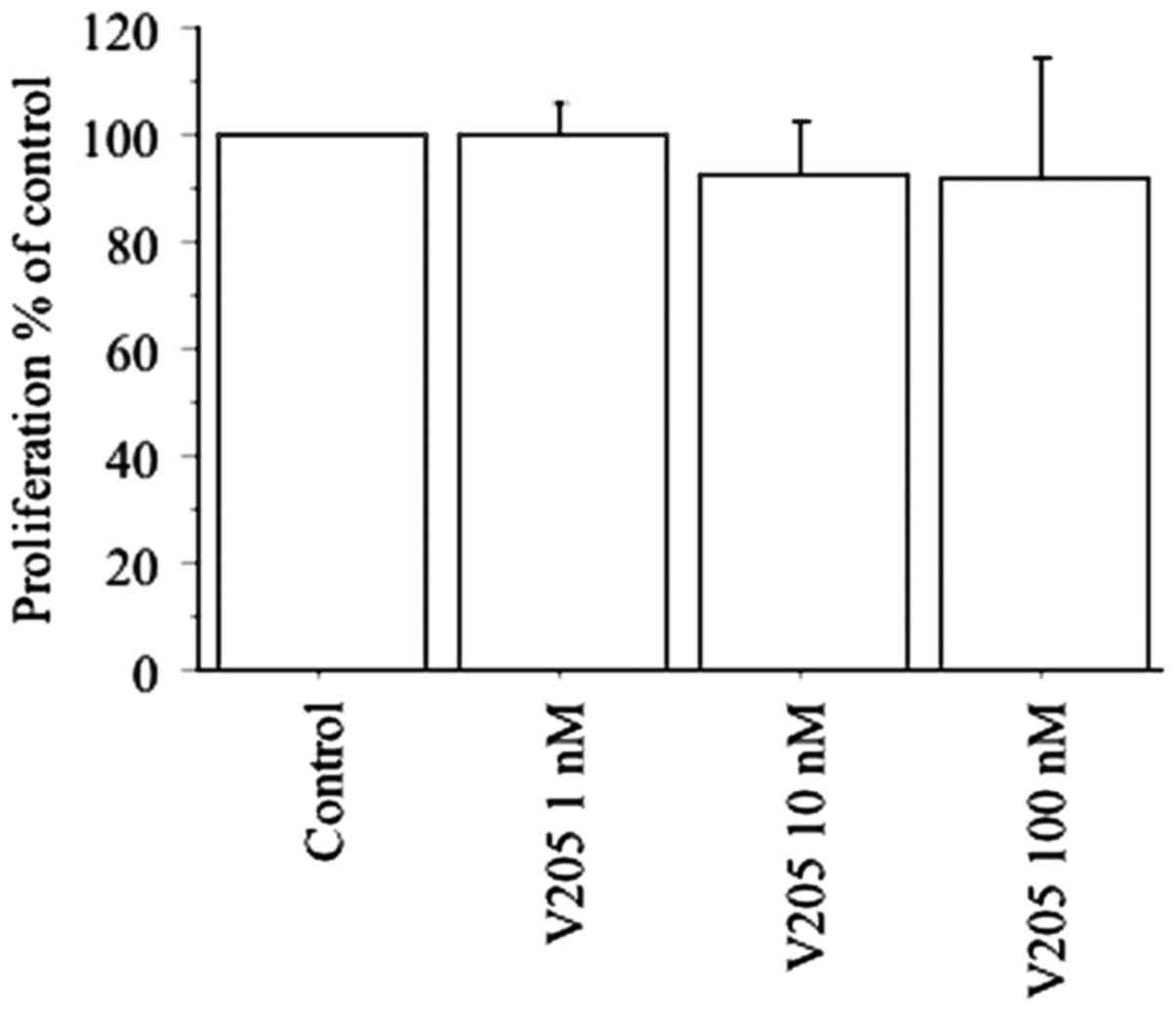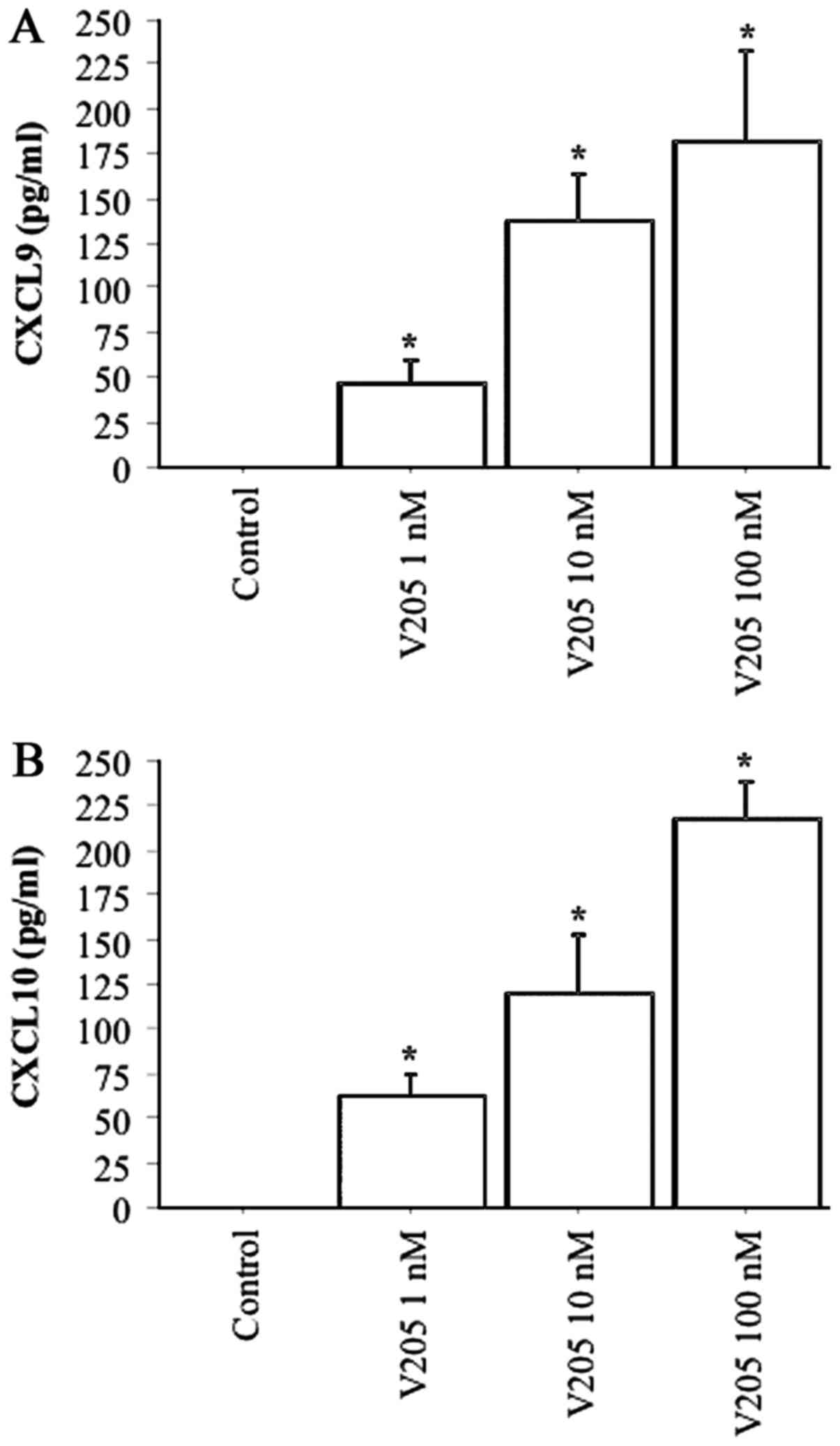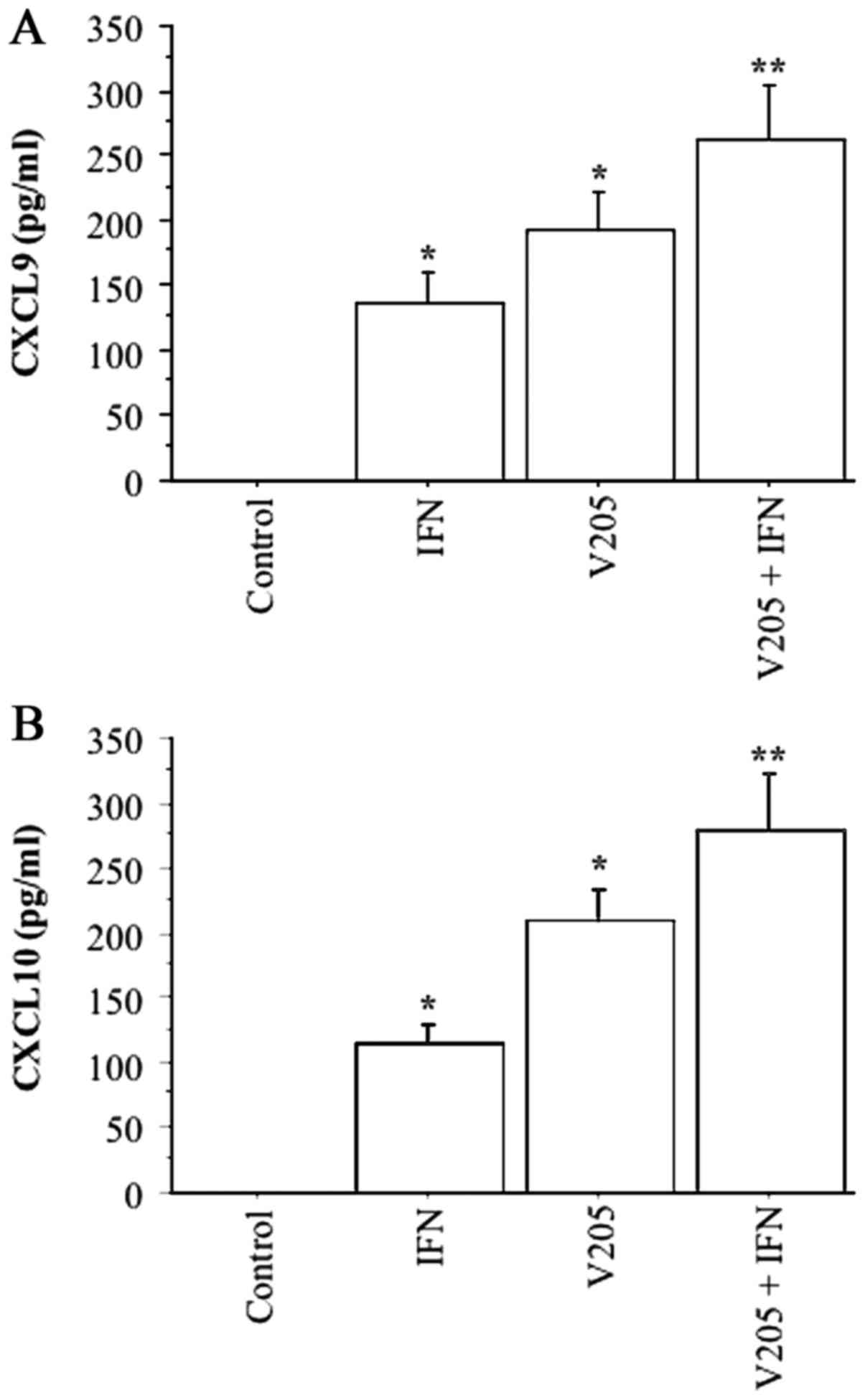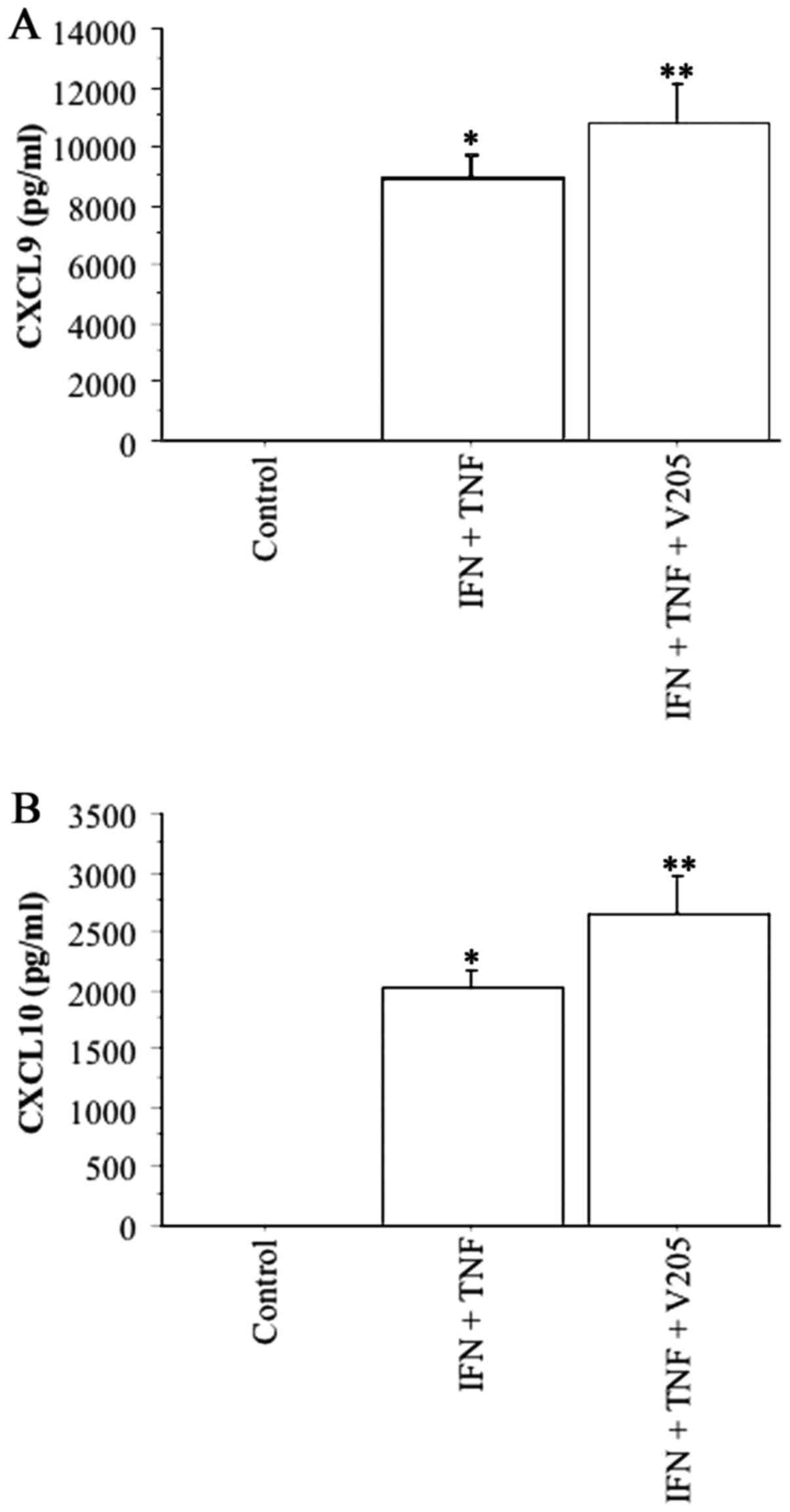Vanadium pentoxide induces the secretion of CXCL9 and CXCL10 chemokines in thyroid cells
- Authors:
- Published online on: March 8, 2018 https://doi.org/10.3892/or.2018.6307
- Pages: 2422-2426
Abstract
Introduction
Vanadium is a grey metal that exists in a number of different states of oxidation: −1, 0, +2, +3, +4 and +5. The most common form in commercial products is vanadium pentoxide (V2O5). All vanadium compounds have been considered toxic. The maximum amount of human V2O5 exposure has been established by the Occupational Safety and Health Administration of the US Department of Labor as 0.05 mg/m3 for dust and 0.1 mg/m3 for fumes, in workplace air for an 8 h workday/40 h work week (1). Exposure to a 35 mg/m3 dose of vanadium is considered life-threatening and could provoke serious and perpetual health issues including death, as determined by The National Institute for Occupational Safety and Health (1).
The respiratory system is the most vulnerable system to the toxic effect of vanadium whereas there is inconsequential action on the gastrointestinal system due to the minimal gut absorption rate of the substance (2–4). Unfortunately, we lack satisfactory data to determine the reference range of a subchronic or chronic inhaled dose. The effects resulting from an oral or inhaled vanadium exposure on serum parameters (5,6), the liver (7), nervous system (8) and development of other tissues have been described in rat models (9).
Recently, the increase in the incidence of thyroid cancer in areas of volcanic activity suggest a carcinogenic effect of volcanic pollution. In the Mount Etna volcanic area, the incidence of thyroid cancer was higher than that in control areas (18.5 and 9.6/105 inhabitants, respectively). In volcanic areas, various trace elements are increased (with respect to control areas) in both lichens and drinking water, indicating atmospheric and water pollution. The amounts of trace elements are significantly increased, among them vanadium which was increased 8 times, and its possible carcinogenic role on the thyroid has been hypothesized (10,11).
However, no in vivo or in vitro studies have evaluated thyroid/endocrine disruption in humans and/or animals after exposure to vanadium. In the present study, we evaluated the effect of V2O5 on the proliferation and chemokine secretion of normal thyrocytes.
Materials and methods
Thyroid follicular cells (TFCs)
We collected 10 specimens of thyroid tissue from 10 euthyroid patients (mean age, 41 years, range 24–61; 5 females, 5 males) (8 undergoing parathyroidectomy, 2 laryngeal intervention). We obtained informed consent from all participants, and the local ethics committee of the University of Pisa provided approval for the study. Thyrocytes were prepared as previously described (12–14). The digestion of tissue samples was carried out by collagenase (Roche Diagnostics GmbH, Mannheim, Germany; 1 mg/ml) with RPMI-1640 (Whittaker Bioproducts, Inc., Walkersville, MD, USA) for 1 h at 37°C. The semi-digested follicles were removed and sedimented for 2 min; they were then washed and cultured with RPMI-1640 medium in the presence of fetal bovine serum (FBS) 10% (Seromed Biochrome, Berlin, Germany), 50 mg/ml penicillin/streptomycin, 2 mM glutamine, with 5% CO2 at 37°C.
Cell viability and proliferation assay
Cell viability and proliferation were evaluated using the WST-1 (Roche Diagnostics, Almere, The Netherlands) assay (which uses 3-[4,5-dimethylthiazol-2-yl]-2,5-diphenyltetrazolium bromide, in the MTT assay) (15–17). TFCs were seeded at a density of 35,000 cells/ml (in a final volume of 100 µl) in each well of 96-well plates. To determine how V2O5 affects TFC proliferation, the cells were treated (24 h) with increasing concentrations of V2O5 (1, 10 and 100 nM). For each cell preparation, the experiments were performed in triplicate. Cells were plated and treated for 24 h with V2O5 or with its vehicle alone.
Proliferation assay: Cell counting
Cell number counting was also used to evaluate the proliferation of TFCs as previously described (15–17).
Chemokine secretion assays
To successfully perform the chemokine (C-X-C motif) ligand (CXCL)9, or CXCL10 secretion assays, 30,000 cells/ml were seeded (in 96-well plates) in a final volume of 100 µl/well, in growth medium, which was then removed (after 24 h). Cells were then washed with phosphate-buffered saline (PBS) and incubated (for 24 h) in serum and phenol red-free medium with interferon (IFN)γ (500, 1,000, 5,000 and 10,000 IU/ml; R&D Systems, Minneapolis, MN, USA) and tumor necrosis factor (TNF)α (10 ng/ml) (R&D Systems), in combination (13) or alone. The TNFα concentration was chosen to obtain the highest secretion in preliminary experiments. The supernatant was then obtained (after 24 h), and kept frozen at −20°C (until chemokine assay).
To understand how V2O5 affects the chemokine secretion induced by IFNγ, the cells were treated (for 24 h) with increasing concentrations of V2O5 (1, 10 and 100 nM), in the presence/absence of IFNγ (1,000 IU/ml) and/or TNFα (10 ng/ml). CXCL9 and CXCL10 in the supernatants were measured by ELISA. The experiments were conducted 3 times with each different cell preparation.
ELISA for CXCL9 and CXCL10
CXCL9 or CXCL10 was assessed in the supernatants from cell cultures by commercially prepared kits (R&D Systems). The minimum (mean) detectable doses were 1.5 or 1.2 pg/ml, for CXCL9, or CXCL10 (respectively). The intra- and inter-assay coefficients of variation were for 3.5 and 6.4%, respectively, for CXCL9, while these coefficients for CXCL10 were 4.5 and 7.3%, respectively. Quality control pools of normal, low and high concentrations were also included in each assay.
Data analysis
For normally distributed variables, the values are expressed in the text as mean (± SD), or mean (± SEM) in figures, otherwise as median [and interquartile range]. Mean group values were compared by using one-way analysis of variance (ANOVA) for variables normally distributed, or with the Kruskal-Wallis test, or Mann-Whitney U test. Proportions were compared by the Chi-square test. The Bonferroni-Dunn test was used for post hoc comparison of normally distributed variables.
Results
Cell proliferation
Cell viability and proliferation assay WST-1 demonstrated that V2O5 (1, 10 and 100 nM) did not alter the viability or proliferation of the TFCs (Fig. 1). These results were confirmed by cell counting (data not shown).
CXCL9
CXCL9 levels were not detectable in supernatants gathered from primary thyrocyte samples, whereas the CXCL9 concentration was increased after dose-dependent induction of IFNγ (0, 61±27, 136±34, 196±41 and 262±67 pg/ml; with IFNγ 0, 500, 1,000, 5,000 and 10,000 IU/ml, respectively; P<0.001 by ANOVA). TNFα alone was not able to promote any impact on CXCL9 (remaining undetectable), while the synergy of IFNγ plus TNFα elicited a significant influence on CXCL9 release (CXCL9, 8976±1456 vs. 142±34 pg/ml with IFNγ alone, P<0.0001 by ANOVA).
Following the treatment of thyrocytes with V2O5 (1, 10 and 100 nM), CXCL9 secretion was dose-dependently stimulated (ANOVA, P<0.0001) (Fig. 2A). Following the treatment of thyrocytes with V2O5 (1, 10 and 100 nM), together with TNFα, CXCL9 secretion was not significantly altered with respect to V2O5 alone (data not shown).
Following the treatment of thyrocytes with V2O5 (100 nM), together with IFNγ, CXCL9 release was synergistically increased (ANOVA, P<0.0001) (Fig. 3A).
Following the treatment of thyrocytes with V2O5 (100 nM), together with IFNγ and TNFα, CXCL9 secretion was synergistically increased (ANOVA, P<0.0001) (Fig. 4A).
CXCL10
CXCL10 was not detectable in the supernatants from primary thyrocyte cultures in basal condition. IFNγ induced CXCL10 secretion dose-dependently (0, 45±22, 111±35, 213±27, 254±64 pg/ml, with IFNγ 0, 500, 1,000, 5,000 and 10,000 IU/ml; respectively; P<0.001 by ANOVA). TNFα only was not able in this case to carry out any impact on CXCL10, while the synergy of IFNγ plus TNFα elicited a significant influence on CXCL10 secretion (2,011±154 vs. 108±26 pg/ml with IFNγ alone; P<0.0001, by ANOVA).
Following treatment of thyrocytes with V2O5 (1, 10 and 100 nM) CXCL10 secretion was stimulated dose-dependently (P<0.0001 by ANOVA) (Fig. 2B). Following treatment of thyrocytes with V2O5 (1, 10 and 100 nM), together with TNFα, CXCL10 secretion was not significantly changed with respect to V2O5 alone (data not shown).
Following treatment of thyrocytes with V2O5 (100 nM), together with IFNγ, CXCL10 release was synergistically increased (P<0.0001 by ANOVA) (Fig. 3B).
Following treatment of thyrocytes with V2O5 (100 nM), together with IFNγ plus TNFα, CXCL10 secretion was synergistically increased (P<0.0001 by ANOVA) (Fig. 4B).
Discussion
The results of the present study demonstrated that V2O5 can promote IFNγ-dependent chemokine secretion by TFCs, without altering the viability and proliferation of the cells. Moreover, as expected (14), our study confirmed that IFNγ and TNFα stimulated the secretion of C-X-C chemokines, CXCL9 and CXCL10, evaluated by ELISA, which is an accepted and commonly published method to dose chemokine levels in supernatants. Notably, V2O5 was able to synergize with IFNγ and TNFα, further increasing chemokine secretion. These results, on the whole, are in agreement with the view that V2O5 is able to induce and perpetuate an inflammatory disorder in the thyroid evolving from a predominant T-helper (Th)1 immune response (15).
In fact, IFNγ-inducible C-X-C chemokines can be secreted by several types of mammalian cells, such as fibroblasts, thyrocytes, islet cells, colon epithelial cells, endothelial cells, and others (12–19). However, in basal condition such cell types do not produce these chemokines, that are secreted after the stimulation with IFNγ (alone or in combination with TNFα), a cytokine that is produced by Th1-activated lymphocytes in several autoimmune diseases, for example in the thyroid in Graves' disease, or in autoimmune thyroiditis. This process has been hypothesized to be involved in the initiation and/or the perpetuation in several autoimmune disorders (12–21), and it can be applied also to the thyroid.
Our results agree with those of other researches in different cell types. V2O5 exposure is a cause of occupational bronchitis, and a study evaluated gene expression profiles in human lung fibroblasts (in cultures) after exposure in vitro to V2O5 in order to identify genes that may play a role in the bronchial inflammation, repair and fibrosis in the pathogenesis of bronchitis. Approximately 12 genes were overexpressed following exposure to V2O5, including chemokines (CXCL9, CXCL10 and interleukin-8) (22). In a second study, it was shown that fibroblasts respond to vanadium oxidative stress by producing IFNβ and activating STAT-1, that led to increased CXCL10 levels (23), playing a role in the innate immune response.
Importantly, vanadium was able to increase chemokine secretion in a dose range, from 1 to 100 nM. It was observed that normal blood levels of vanadium range from 0.45 to 18.4 nM, and that 100 nM is a dose that may mimic an abnormally high exposure (24).
The mechanisms by which V2O5 induces lung cancer have been investigated in mice in numerous studies. Experts agree that in vivo and in vitro research suggests that cancers are induced by secondary mechanisms (probably not genotoxic effects) (25).
Thus, we hypothesized that, also for the thyroid, the induction and perpetuation of an inflammatory reaction into this gland, and the variety of involved candidate genes could predispose to the appearance of thyroid cancer (as recently demonstrated for the association of papillary thyroid cancer and autoimmune thyroiditis), and could be at the basis of V2O5-induced effects after occupational and environmental exposure.
In conclusion, the present study showed that V2O5 is able to induce the secretion of Th1 chemokines into the thyroid, synergistically increasing the effect of important Th1 cytokines such as IFNγ and TNFα, leading to the induction and perpetuation of an inflammatory reaction in the thyroid. Further studies are necessary to investigate the mechanism of action by which chemokines are secreted, and to evaluate thyroid function, and nodules, in subjects occupationally exposed, or living in polluted areas.
Acknowledgements
Not applicable.
References
|
‘Occupational Safety and Health Guidelines for Vanadium Pentoxide’. Occupational Safety and Health Administration. https://www.osha.gov/SLTC/healthguidelines/vanadiumpentoxidedust/recognition.htmlRetrieved 29 January 2009. | |
|
Sax NI: Dangerous Properties of Industrial Materials. 6th. Van Nostrand Reinhold Company; New York: pp. 2717–2720. 1984 | |
|
Ress NB, Chou BJ, Renne RA, Dill JA, Miller RA, Roycroft JH, Hailey JR, Haseman JK and Bucher JR: Carcinogenicity of inhaled vanadium pentoxide in F344/N rats and B6C3F1 mice. Toxicol Sci. 74:287–296. 2003. View Article : Google Scholar : PubMed/NCBI | |
|
Wörle-Knirsch JM, Kern K, Schleh C, Adelhelm C, Feldmann C and Krug HF: Nanoparticulate vanadium oxide potentiated vanadium toxicity in human lung cells. Environ Sci Technol. 41:331–336. 2007. View Article : Google Scholar : PubMed/NCBI | |
|
Scibior A, Zaporowska H and Ostrowski J: Selected haematological and biochemical parameters of blood in rats after subchronic administration of vanadium and/or magnesium in drinking water. Arch Environ Contam Toxicol. 51:287–295. 2006. View Article : Google Scholar : PubMed/NCBI | |
|
González-Villalva A, Fortoul TI, Avila-Costa MR, Piñón-Zarate G, Rodriguez-Laraa V, Martínez-Levy G, Rojas-Lemus M, Bizarro-Nevarez P, Díaz-Bech P, Mussali-Galante P, et al: Thrombocytosis induced in mice after subacute and subchronic V2O5 inhalation. Toxicol Ind Health. 22:113–116. 2006. View Article : Google Scholar : PubMed/NCBI | |
|
Kobayashi K, Himeno S, Satoh M, Kuroda J, Shibata N, Seko Y and Hasegawa T: Pentavalent vanadium induces hepatic metallothionein through interleukin-6-dependent and -independent mechanisms. Toxicology. 228:162–170. 2006. View Article : Google Scholar : PubMed/NCBI | |
|
Soazo M and Garcia GB: Vanadium exposure through lactation produces behavioral alterations and CNS myelin deficit in neonatal rats. Neurotoxicol Teratol. 29:503–510. 2007. View Article : Google Scholar : PubMed/NCBI | |
|
Barceloux DG and Barceloux D: Vanadium. J Toxicol Clin Toxicol. 37:265–278. 1999. View Article : Google Scholar : PubMed/NCBI | |
|
Malandrino P, Russo M, Ronchi A, Minoia C, Cataldo D, Regalbuto C, Giordano C, Attard M, Squatrito S, Trimarchi F, et al: Increased thyroid cancer incidence in a basaltic volcanic area is associated with non-anthropogenic pollution and biocontamination. Endocrine. 53:471–479. 2016. View Article : Google Scholar : PubMed/NCBI | |
|
Ferrari SM, Fallahi P, Antonelli A and Benvenga S: Environmental issues in thyroid diseases. Front Endocrinol. 8:502017. View Article : Google Scholar | |
|
García-López MA, Sancho D, Sánchez-Madrid F and Marazuela M: Thyrocytes from autoimmune thyroid disorders produce the chemokines IP-10 and Mig and attract CXCR3+ lymphocytes. J Clin Endocrinol Metab. 86:5008–5016. 2001. View Article : Google Scholar : PubMed/NCBI | |
|
Antonelli A, Ferri C, Fallahi P, Ferrari SM, Frascerra S, Sebastiani M, Franzoni F, Galetta F and Ferrannini E: High values of CXCL10 serum levels in patients with hepatitis C associated mixed cryoglobulinemia in presence or absence of autoimmune thyroiditis. Cytokine. 42:137–143. 2008. View Article : Google Scholar : PubMed/NCBI | |
|
Antonelli A, Ferrari SM, Fallahi P, Frascerra S, Santini E, Franceschini SS and Ferrannini E: Monokine induced by interferon gamma (IFNgamma) (CXCL9) and IFNgamma inducible T-cell alpha-chemoattractant (CXCL11) involvement in Graves' disease and ophthalmopathy: Modulation by peroxisome proliferator-activated receptor-gamma agonists. J Clin Endocrinol Metab. 94:1803–1809. 2009. View Article : Google Scholar : PubMed/NCBI | |
|
Antonelli A, Rotondi M, Fallahi P, Romagnani P, Ferrari SM, Buonamano A, Ferrannini E and Serio M: High levels of circulating CXC chemokine ligand 10 are associated with chronic autoimmune thyroiditis and hypothyroidism. J Clin Endocrinol Metab. 89:5496–5499. 2004. View Article : Google Scholar : PubMed/NCBI | |
|
Antonelli A, Ferrari SM, Frascerra S, Pupilli C, Mancusi C, Metelli MR, Orlando C, Ferrannini E and Fallahi P: CXCL9 and CXCL11 chemokines modulation by peroxisome proliferator-activated receptor-alpha agonists secretion in Graves' and normal thyrocytes. J Clin Endocrinol Metab. 95:E413–E420. 2010. View Article : Google Scholar : PubMed/NCBI | |
|
Kemp EH, Metcalfe RA, Smith KA, Woodroofe MN, Watson PF and Weetman AP: Detection and localization of chemokine gene expression in autoimmune thyroid disease. Clin Endocrinol. 59:207–213. 2003. View Article : Google Scholar | |
|
Antonelli A, Ferrari SM, Corrado A, Ferrannini E and Fallahi P: CXCR3, CXCL10 and type 1 diabetes. Cytokine Growth Factor Rev. 25:57–65. 2014. View Article : Google Scholar : PubMed/NCBI | |
|
Antonelli A, Ferrari SM, Giuggioli D, Ferrannini E, Ferri C and Fallahi P: Chemokine (C-X-C motif) ligand (CXCL)10 in autoimmune diseases. Autoimmun Rev. 13:272–280. 2014. View Article : Google Scholar : PubMed/NCBI | |
|
Fallahi P, Ferrari SM, Ruffilli I, Elia G, Biricotti M, Vita R, Benvenga S and Antonelli A: The association of other autoimmune diseases in patients with autoimmune thyroiditis: Review of the literature and report of a large series of patients. Autoimmun Rev. 15:1125–1128. 2016. View Article : Google Scholar : PubMed/NCBI | |
|
Antonelli A, Fallahi P, Delle Sedie A, Ferrari SM, Maccheroni M, Bombardieri S, Riente L and Ferrannini E: High values of Th1 (CXCL10) and Th2 (CCL2) chemokines in patients with psoriatic arthtritis. Clin Exp Rheumatol. 27:22–27. 2009.PubMed/NCBI | |
|
Ingram JL, Antao-Menezes A, Turpin EA, Wallace DG, Mangum JB, Pluta LJ, Thomas RS and Bonner JC: Genomic analysis of human lung fibroblasts exposed to vanadium pentoxide to identify candidate genes for occupational bronchitis. Respir Res. 8:342007. View Article : Google Scholar : PubMed/NCBI | |
|
Antao-Menezes A, Turpin EA, Bost PC, Ryman-Rasmussen JP and Bonner JC: STAT-1 signaling in human lung fibroblasts is induced by vanadium pentoxide through an IFN-beta autocrine loop. J Immunol. 180:4200–4207. 2008. View Article : Google Scholar : PubMed/NCBI | |
|
Sabbioni E, Kuèera J, Pietra R and Vesterberg O: A critical review on normal concentrations of vanadium in human blood, serum, and urine. Sci Total Environ. 188:49–58. 1996. View Article : Google Scholar : PubMed/NCBI | |
|
Assem FL and Levy LS: A review of current toxicological concerns on vanadium pentoxide and other vanadium compounds: Gaps in knowledge and directions for future research. J Toxicol Environ Health B Crit Rev. 12:289–306. 2009. View Article : Google Scholar : PubMed/NCBI |













